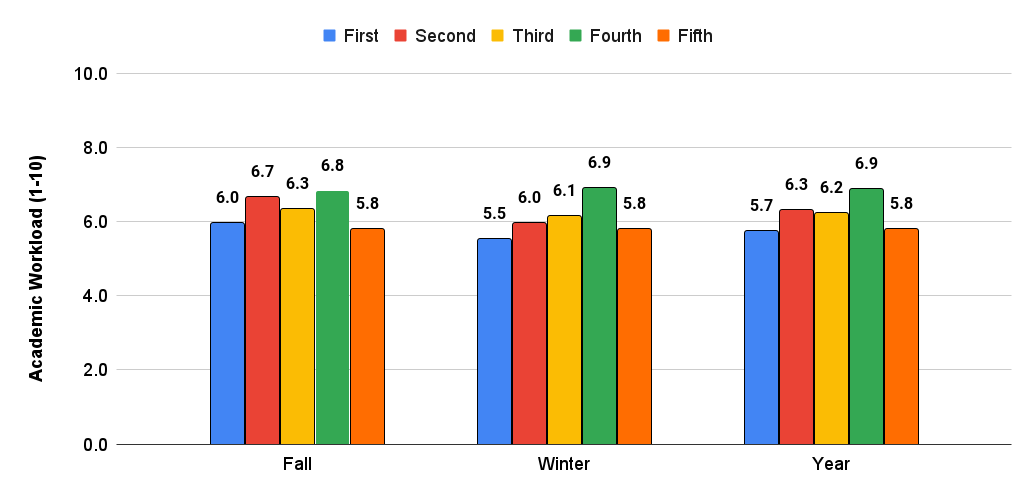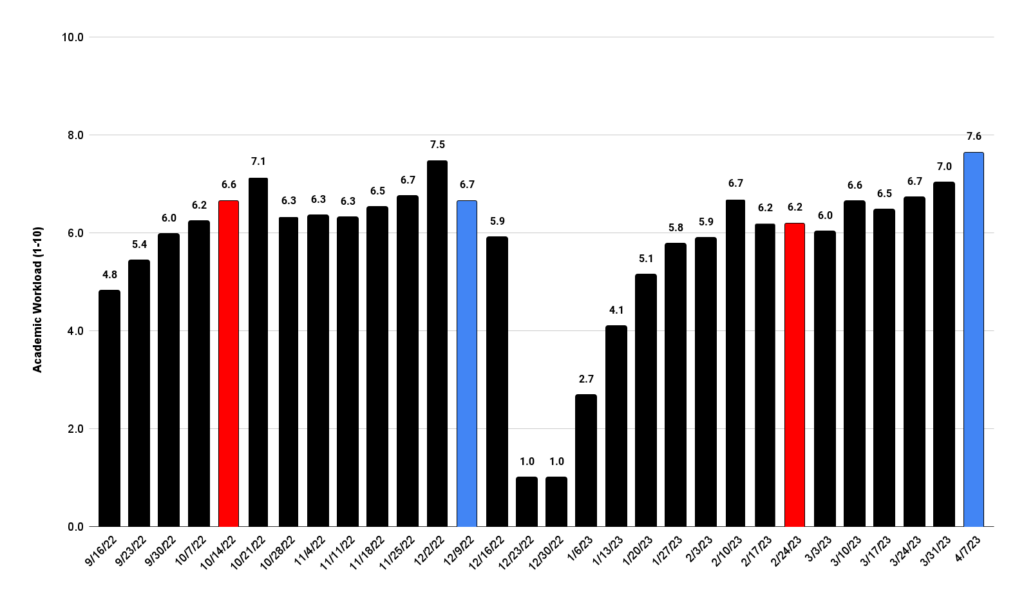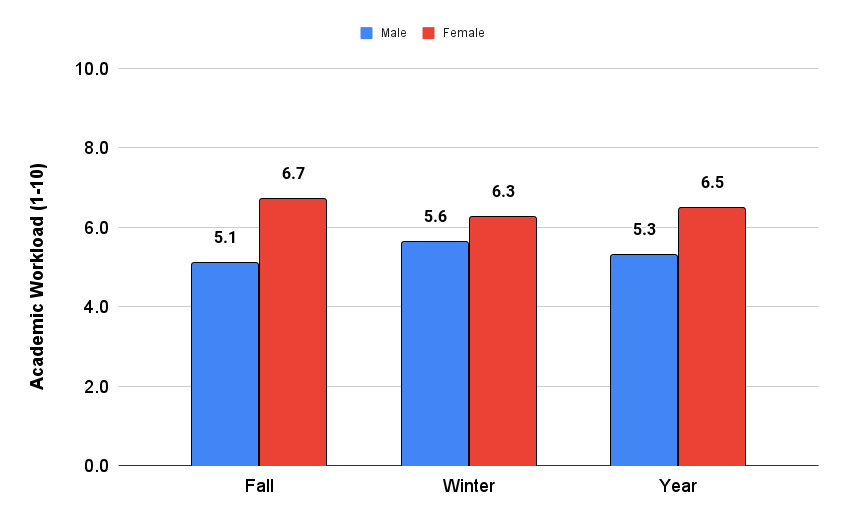Monitoring Academic Workload in USPORTS Athletes

As sport performance coaches, one of our goals is to train athletes to withstand the stresses of playing their sport. This includes the management of physical stresses between the weight room and practices to elicit better performance and mitigate injuries (1).
Stress is any form of pressure or tension placed onto a system that elicits adaptations that are either positive or negative. The training process brings stress to the system with the goal of creating a positive change. However, the body interprets different stimuli, both cognitive and environmental, as forms of stress (1). Therefore, the cumulative stress of multiple factors can have negative impacts on not only performance but also physical and mental health (2).
In a study performed during an NCAA Division one football season, researchers tracked injuries and illnesses over the course of the season and compared it with periods of high physical and academic volume (2). High physical volume referred to weeks the team completed training camp (3 out of 20 weeks) and high academic volume referred to university-wide exam weeks (4 out of 20 weeks). All other weeks were either considered low physical, or low academic stress. They determined that injury rates were more likely to occur during times of high physical stress. But what was of particular interest was that injuries were two times more likely to occur in weeks with high academic stress versus low academic stress. More impactful, starting athletes were three times more likely to sustain an injury in weeks with high academic stress compared to low academic stress. The authors concluded that both psychological stress and physical stress play a significant role in the occurrence of physical injuries for college football players.
The college experience represents a time of meaningful change and growth for young adults. A college student will take on immense academic pressures, social demands, financial burdens, and the realities of living on their own for the first time. On top of all these major life changes, an incoming athlete will also have to manage a substantial commitment to their sport which includes team activities, training, practice, and games. Between sport and academics, student-athletes are constantly between two sides competing for their attention, sacrifice, and excellence. As sport coaches it is critical to acknowledge the academic stress of student-athletes at any level, respect the impact it can have on adaptation, and coordinate our training plan accordingly (2).
At York University we performed monitoring of a student athlete pool to better understand the changes in academic workload within student-athletes at the U SPORTS level over the course of a fall/winter athletic schedule. This data will help better inform sports performance staff and coaches on how to plan around academic schedules.
Methods
For this informal study, four varsity sports programs that compete in the fall and winter semesters were surveyed as part of their regular training program. There were 77 total athletes including 58 females and 17 males. There were 21 first, 19 second, 17 third, 8 fourth, and 11 fifth-year athletes. All participants included in this study averaged 90%+ adherence to the questionnaire over the fall/winter semesters.
The collection period spanned 30 weeks starting September 11, 2022 and concluded April 8, 2023. Using an online cloud-based workout platform, participants provided their perceived academic workload on a scale of 1 – 10 (1 = extremely low/light, 10 = extremely high/heavy) on a weekly basis (Fridays). Athletes gauged the academic workload they endured based on the week that just passed and what they expected in the following week.
Results
Perceived academic workload was averaged across participants for each training week with the lowest academic workload occurring the first week of the Fall semester (September 16, 2022) and the first week of the Winter semester (January 6, 2023). The Christmas break was excluded from analysis. The highest average perceived workload for the year occurred during final exams of each semester (December 2, 2022; and April 7, 2023) (Figure 1).

Average perceived workload across each semester was also compared between male and female athletes. Females reported a higher perceived academic workload average than males, however a statistical analysis was not performed to determine significance (Figure 2)

Perceived academic workload was also compared between academic years and fourth-year student-athletes had the highest perceived workload with second- and third-year students in the middle range and first and fifth students recording the lowest perceived workload (Figure 3).

Discussion
Over the thirty weeks of monitoring, the perceived academic workload changed every week except for three weeks in the fall and two in the winter. Both the fall and winter semesters followed a similar trend both starting the first week with the lowest average of the semester. Both semesters’ averages increased for the first six weeks and peaked the week after, or the week prior to reading week. After this initial peak, both semesters had a slight drop and plateau phase lasting three weeks. Three weeks prior to exams starting, the group average begins to increase with the highest scores of the year occurring the week before, or the week of, semester final exams commencing.
Based on the year’s results, there are four major academic stress spikes over the fall/winter calendar. Each of these represents a time in which sport performance coaches, need to carefully plan and monitor our athlete’s workloads and volume. Coincidently, these higher periods of academic stress occur when the university pauses or concludes classes and professors will administer mid-term, or final exams. In response, sports performance coaches often use reading weeks as an opportunity to increase sport workload because their athletes are out of class. However, due to the high academic demands, sports performance coaches should use the reading week as an opportunity to reduce sports volume, if the athlete’s schedule allows, it to avoid accumulating too much stress.
Using the first four weeks of the semester, sports performance coaches should aim to gradually accumulate volume in tandem with academic stress. During the first wave of midterms, coaches can limit sports volume by performing a maintenance or deload week (if sport allows it). Following the wave of midterms, sports coaches can build more volume or intensity in sports as class stress plateaus. Toward the end of the semester, coaches can consider going into a maintenance phase in which they drop volume and focus on quality intensity sports exposures as the academic workload ramps up again.
Academic workload, and in turn stress, had differences between gender and year of study. During the fall and winter semesters, as well as over the year, female student-athletes had higher academic workload s than males. Males seem to perceive times of high academic workload as less stressful than females. This perceived stress measurement tool has not been validated and no statistical analysis was performed, so this could be artifact of the measurement tool used or of gender differences in stress reporting. Alternatively, this could be due to differences in internal pressure to achieve elevated levels of academic success in which males are more comfortable receiving lower letter grades. The problem with this is that academic workload/stress does not seem to relate to overall performance in academics. The stress of some athletes receiving a B instead of an A grade may be similar to another athlete receiving a D instead of a B grade. Therefore, this measurement tool does not offer clarity on this observation. It could indicate, however, that extra support systems may need to be in place for female teams.
Although as an institution the university and athletic department want each student-athlete to achieve academic success, certain athletes will be more driven towards that than others. In turn, the stress athletes interpret will depend on how they view academics. In some cases when an athlete is not stressed, but also is not doing well academically, it raises the potential of failing a course.
A sports performance coach needs to understand each member of their team, the program they are taking, their registered classes, and the goals they have academically. This could allow coaches to individualize their periodization for each athlete on the team based on their personal academic schedule, demands, and goals.
Overall, fourth-year student-athletes averaged the highest academic workload over the year, and in both semesters. Interestingly, first year and fifth year student-athletes were the lowest over the year and in both semesters. Student-athletes in their first, second, or third year all had higher average academic workload in the fall semester compared to the winter semester. Fourth- and fifth-year athletes maintained the same score over both semesters.
Course workload, schedules, and course selection options will vary across years. Early on in any undergraduate degree, there are limited course selection opportunities compared to upper years in the program. A team that is dominated by first-year athletes will have different academic workload constraints than a team that is full of third- and fourth-year athletes. Interestingly, the fall semester academic workload average was higher for first, second-, and third-year athletes suggesting a bit of accommodation occurring in the fall semester as they regulate the school year again. The decline in the winter semester suggests that as sport coaches we must consider the accumulation of academic load in the fall semester over the winter in their periodization plan. First-year to fourth year student-athletes had progressively increasing academic workloads with each year. Fifth-year student-athletes, on the other hand, are in a unique category often having finished their core course requirements and usually taking electives to finish their degree therefore creating a reduced course load.
Conclusion
In the end, stress is stress. Regardless of the cause of stress, whether physical or psychological, it all affects human systems. Too much stress accumulated in too short of a period limits the system’s ability to adapt and can cause negative adaptation. As sports professionals collaborating with athletes who are still in school, it is critical to acknowledge the academic workload in your planning. Understand where your athlete is in their academic journey, what their academic aspirations and goals are, how committed are they academically, and how they react to times of high workload. In the university sector it is the reality of the game, Therefore, you must adapt your systems to consider the whole student athlete experience to optimize performance outcomes.
Author Bio
Emerson Morassutti is currently the Head Strength and Conditioning Coach at York University. At York, Emerson oversees the strength and conditioning department which includes the training of 10 varsity sport programs.
References
- Bove, D. (2021) The quadrant system: Navigating stress in team sport (paperback), Athlete Framework. Available at: https://www.athleteframework.com/product-page/the-quadrant-system-navigating-stress-in-team-sport (Accessed: 26 June 2023).
- Lopes Dos Santos, M. et al. (2020) Stress in academic and athletic performance in collegiate athletes: A narrative review of sources and Monitoring Strategies, Frontiers in Sports, and Active Living, 2. doi:10.3389/fspor.2020.00042.
- Mann, J.B. et al. (2016) Effect of physical and academic stress on illness and injury in Division 1 college football players, Journal of Strength, and Conditioning Research, 30(1), pp. 20–25. doi:10.1519/jsc.0000000000001055.






